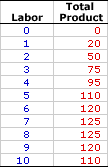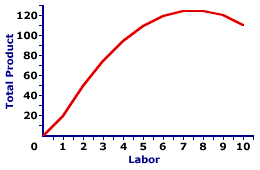
|
|
REAL PURCHASING POWER: The ability to acquire wants-and-needs satisfying goods and services with income or money. The real purchasing power of income or money depends on the prices of the goods and services. If the price level, for example, doubles, then a given amount of money can purchase half as many goods and services.
Visit the GLOSS*arama
|
|


|

|
                           TOTAL PRODUCT: The total quantity of output produced by a firm for a given quantity of inputs. Total product is the foundation upon which the analysis of short-run production for a firm is based. The usual framework is to analyze total product when a variable input (labor) changes, while a fixed input (capital) does not change. Two related concepts derived from total product are average product and marginal product. Total product is the overall quantity of output that a firm produces, usually specified in relation to a variable input. Total product is the starting point for the analysis of short-run production. It indicates how much output a firm can produce according to the law of diminishing marginal returns.Total Taco Production| Total Taco Product |  |
The table to the right provides a few hypothetical numbers that can be used to investigate the relation between total product and the variable input. These numbers represent the hourly production of Shady Valley's favorite meal, Super Deluxe TexMex Gargantuan Tacos (with sour cream and jalapeno peppers).The column on the left is the variable input, specifically the number of workers employed by Waldo's TexMex Taco World, which ranges from 0 to 10. While the number of workers is variable, the quantity of capital, specifically the restaurant associated equipment, is fixed. The column on the right is the total product, the total number of TexMex Gargantuan Tacos produced each hour. Total product, Gargantuan Taco production, ranges from a low of 0 to a high of 125. Note that 125 TexMex Gargantuan Tacos is NOT that production achieved with all 10 workers, but rather the production for either 7 or 8 workers. Maximum production does NOT necessarily result from maximum use of the variable input. What other sorts of observations can be made about this table? - For one, total Gargantuan Taco production generally increases with the employment of extra workers, at least for the first 8 workers. This should be expected. If a firm uses more inputs, then it should get more output.
- For two, total Gargantuan Taco production does not ALWAYS increase with extra workers. Total product does reach a maximum of 125 Gargantuan Tacos with the employment of 7 workers, remains 125 Gargantuan Tacos with 8 workers, then falls with the addition of the 9th and 10th workers.
- For three, total Gargantuan Taco production increases a great deal for the first and second workers, but it does not increase nearly as much for the 6th and 7th workers.
Two Production RulesThese total Gargantuan Taco production numbers suggest two notable short-run production rules:- First, continuing to add a variable input to a fixed input ultimately leads to a maximum total product. Given the fixed size of the Waldo's TexMex Taco World restaurant and associated capital, there is just no way to produce more than 125 Gargantuan Tacos. The capacity of this capital is reached with 7 workers.
- Second, total product does not increase in a linear fashion as more of a variable input is added to a fixed input. The first few workers contribute more to the production of Gargantuan Tacos than subsequent workers. This is not because the first few workers are better, more highly skilled, or more dedicated. As far as Gargantuan Taco production is concerned all workers are identical. Something else is afoot here.
The Law of Diminishing Marginal ReturnsTotal product does not increase in a linear fashion due to the law of diminishing marginal returns. This law states that as more of a variable input is added to a fixed input in short-run production, then the marginal product (that is, the marginal returns) of the variable input eventually declines.For example, the second employee of Waldo's TexMex Taco World might increase taco production from 20 to 50 (a change of 30 tacos), the sixth worker increases production only from 110 to 120 (a change of 10 tacos). The Total Product Curve| Total Product Curve |  |
The total product curve is a graphical representation of the relation between the total product and the variable input. The total product curve for Gargantuan Taco production is displayed to the right.The "overall" slope of this curve is positive, with extra workers "generally" leading to greater production. However, the curve has a distinctive shape, emerging steeply from the origin, then flattening, and eventually declining. The shape of this curve is attributable to the law of diminishing marginal returns. Consistent with the numbers in the table, the curve reaches a peak of 125 Gargantuan Tacos at both 7 and 8 workers. To the left of this peak of 125 Gargantuan Tacos, extra workers increase the production and to the right of the peak extra workers actually reduce total taco production. Average and MarginalTwo related product measures are derived directly from total product--average product and marginal product.- Average Product: This is the amount of output produced per worker, found by dividing the total product by the number of workers. If, for example, Waldo's TexMex Taco World has a staff of 5 that generates a total product of 110 tacos, then average product is 22 tacos.
- Marginal Product: This is the change in total product resulting from a change in the number of workers. Marginal product indicates how the total production of TexMex Gargantuan Tacos changes when an extra worker is hired or fired. For example, hiring a 5th worker means that Waldo's TexMex Taco World total product increases from 95 to 110 tacos. The addition of 5th worker results in the production of an additional 15 TexMex Gargantuan Tacos.

Recommended Citation:TOTAL PRODUCT, AmosWEB Encyclonomic WEB*pedia, http://www.AmosWEB.com, AmosWEB LLC, 2000-2025. [Accessed: June 30, 2025].
Check Out These Related Terms... | | | | | | | | | |
Or For A Little Background... | | | | | | | | | | | | | |
And For Further Study... | | | | | | | | | | | | |
Search Again?
Back to the WEB*pedia
|



|

|
|
The 22.6% decline in stock prices on October 19, 1987 was larger than the infamous 12.8% decline on October 29, 1929.
|

|
|
"I learned about the strength you can get from a close family life. I learned to keep going, even in bad times. I learned not to despair, even when my world was falling apart. I learned that there are no free lunches. And I learned the value of hard work. " -- Lee Iacocca
|

|
ACBS
Accrediting Commission for Business Schools
|

|
|
Tell us what you think about AmosWEB. Like what you see? Have suggestions for improvements? Let us know. Click the User Feedback link.
User Feedback
|


|


